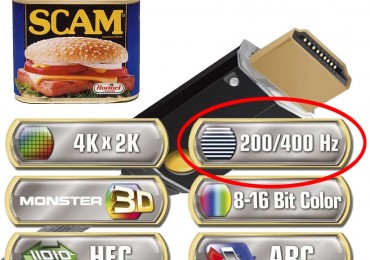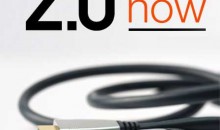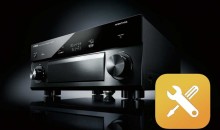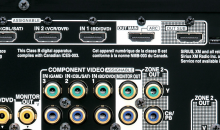Do I Need a 120Hz HDMI Cable?
With all of the talk of “High Speed” HDMI cables coupled with the advances of 120Hz (or higher) video processing found in many televisions, it’s not uncommon to find cable manufacturers writing confusing lingo on their cables. Some of that confusing lingo is causing many consumers to wonder if they need a 120Hz HDMI cable. Rest assured of two things: 1) the answer to that question is a decided “No”, and 2) there is no such thing as a 120Hz HDMI cable.
Let me repeat that for the sake of extreme clarity: There is no such thing as a 120Hz HDMI cable.
Now, there IS such a thing as a “high speed” HDMI cable, but the reasons for that are tied to the resolution and color depth of the signal being transmitted. Everything still tops out at 60Hz—even if the display is doing fancy things to make up new frames of video and generate 120Hz (or higher) signals. In a sense, the term “high speed”, coupled with the high frame rate advertisements of many television manufacturers has opened up a vast opportunity for misunderstanding and, sadly, misrepresentation to consumers.
120Hz Displays Don’t Need “120Hz” HDMI Cables
What’s important to understand is the simple fact that these new 120Hz displays don’t need special cables. The refresh rate happens AT THE DISPLAY not at the source. That means that the 120Hz or 240Hz signal never actually travels along the cable. It is created at the display from a 60Hz signal. You simply want to ensure that the HDMI cable you choose is certified to handle the data you want to send across it—for the entire distance you want to send it. You no more have to worry about a 120Hz designation affecting the cable more than you have to worry about cable color affecting it.
In general, we only recommend “High Speed” HDMI cables since they, by default, handle all of the video and audio requirements of 1080p high definition video content.
The issue wouldn’t be so bad if it weren’t for poorly-trained sales associates across the country. They seem bent on miscommunicating the 120Hz myth to unsuspecting consumers who are more than happy to pay more to ensure their cables are compatible with their new TVs. On top of that, some companies are including “120Hz” and “240Hz” designations on their packaging, further adding to the confusion. These companies also engage in training sales associates to communicate the 120Hz myth as a “necessary” feature of an HDMI cable being paired with one of these new televisions.
Don’t fall for the hype.
Understanding 120/240/480 Hertz
All televisions had to pass a particular number of frames per second in order to fool the human eye/brain system into seeing a real-time motion picture. This number was arrived at by a common factor of the number of frames needed to make a realistic video (roughly 24 or more) and the frequency with which our country’s power lines are configured (60Hz). Modern displays tend to run video content at either 30Hz or 60Hz depending upon which mode they are in and what we’re looking at (Blu-ray, 720p cable TV, 1080i cable TV, etc). 60 Hertz was quickly the perfect solution for video since it allowed for 30 frames per second represented by two fields per frame (60 fields per second).
When LCD televisions hit the market, manufacturers quickly attempted various methods to alleviate a problem that was noticed: pixel latency or blurring. To aid in fixing this, and to create a “faster” display, 120Hz was born. Some manufacturers have taken this to extremes and you will see advertisements of 240Hz, 480Hz—even 960Hz! For the most part, the bottom line is that everything is a multiple of that original 60Hz and there is no high frame rates over 60 being sent over HDMI cables.
Bitrate or Frame Rate?
The refresh rate of a display has nothing to do with the requirements of an HDMI cable, but the bitrate has everything to do with it. Bitrate is a function of the resolution of the source signal along with its color depth and frame rate. Since all current transmitted frame rates are maxed out at 60Hz, the resolution and color depth are the real deciding factors.
Again, since the new 120Hz signals are only achieved at the display and never transmitted over the cable, that increased frame rate provides no extra demand on your cables.
Conclusion
Blu-ray transmits 24 frames per second (fps), and your cable box likely sends out 30 fps or 60 fps. So, whether or not you have a 120Hz display, there’s simply no need to upgrade your cables or pay more for a “120Hz” model. If a salesman is being a monster and pushing 120Hz cables on you, just politely decline and go grab a cheaper high speed-rated HDMI cable.







Ya some morons will fall into the 120hz tv for the cable setup but you seem to only cater to those morons. What about the people who bought 120hz tvs to use with 120hz sources. and before you go all cnet on my ass and say theres no such thing I got 2 letters for you. PC
Then you should probably be using display port and a dedicated sound card.
with hdmi cant i got no 120hz option is in display driver as i get 120 with Dual Link DVI and it is so much smooth compared to 60hz on 120hz panel.. Cable does matter for my case
Hdmi 1.4b supports the 120Hz 1080p throughput only for 3D processing, which it does by cloning the data packet for concurrent output to the display device. For 2D viewing – which is what almost all gamers mean when they want “120Hz” – HDMI 1.4b is stuck at just 60Hz for 1080p.
For HDMI 2.0, 1080p120 falls well within the 600MHz pixel clock and 18Gbps throughput cap (even accounting for 8b/10b encoding). It is possible for 1080p to be supported at 120Hz on HDMI 2.0; unfortunately, very few solutions on-market are capable of actually utilizing this potential. Most monitors selling with HDMI 2.0, like the ASUS PB287Q, are 4K displays that cap-out at 60Hz. This is because HDMI is ultimately a consumer interface that’s targeted at TVs
You are correct. Although sadly the cable and throughout signals only can do 4K/1080P pictures by pictures in scaling including possibility in some case cheap TV from the HDMI. Some panel out there could receives120HZ on back to back to the screen and panel to the connections signals from the HDMI and other as new sources such as 10240 x 4320 @ 120 (version 2.1) updates
I am into the new styles as DisplayPort 32-pin 8192 × 4320 @ 240HZ- ( Version 1.4)120HZ-( Version 2.0)
I heard there a Duallink Displayports out there that is able to do beyond for major sound system supports as well from chip switching. These days I rather used the Fiber optic cables for major DTS and AMOS or any major sound system. TV Monitor panels should be able to support any new CoaXPress (CXP) is an asymmetric high speed serial communication standard over coaxial cable. 4x CXP-6 25 Gbit/s, up to 68 m. So basically we will be going back to cable.